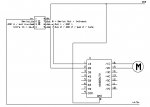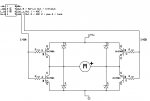marcos.placona
Senior Member
Hi guys, I know it's been discussed here several times, and even I started a topic some months ago to discuss about this kind of approach.
I've been trying to drive some 3v motors (toy), but got stuck in a point. I know it must be pretty simple, but what I'm trying to do is run this motor forwards and reverse.
I'm attaching here the mock up schematics I've been working on for this driver, and I know the main flaw on it, it that it's being powered up by the picaxe, which can just provide something like 20mA, and this motor can drain 300mA.
I know this is the flaw, and that's why the motor is not running. But I don't really know how to go about wiring this motor to an external power source.
I've seen the schematics on the pdf3 page 6, where it shows how to wire the motor to an external source, but in this case I suppose you can only run the motor in one direction, which wouldn't be of much help.
Can anyone give me a hint about what would be a better solution, but still using the ULN2003 for my h-bridge?
Thanks in advance,
Marcos Placona
I've been trying to drive some 3v motors (toy), but got stuck in a point. I know it must be pretty simple, but what I'm trying to do is run this motor forwards and reverse.
I'm attaching here the mock up schematics I've been working on for this driver, and I know the main flaw on it, it that it's being powered up by the picaxe, which can just provide something like 20mA, and this motor can drain 300mA.
I know this is the flaw, and that's why the motor is not running. But I don't really know how to go about wiring this motor to an external power source.
I've seen the schematics on the pdf3 page 6, where it shows how to wire the motor to an external source, but in this case I suppose you can only run the motor in one direction, which wouldn't be of much help.
Can anyone give me a hint about what would be a better solution, but still using the ULN2003 for my h-bridge?
Thanks in advance,
Marcos Placona
Attachments
-
51.7 KB Views: 74



